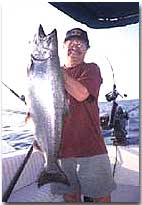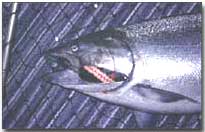The Salmon Edge
The Salmon Edge
White-caps stood shoulder to shoulder at the seawall, jostling like an angry mob against the ramparts of a stone fortress. Arching green rollers driven by a wild southwesterly towered menacingly, as anglers waited impatiently to put out to sea. When we finally left port, the lake had settled, but the aftermath of the heavy blow streaked the surface with long lines of debris.
Fishing patterns developed over weeks of stable weather had vanished. Under these conditions, experience dictates that you start with the basics and build new patterns. I start at a "salmon edge." It might be structure such as shoals, reefs, or dropoffs that create a physical edge; an invisible wall created by water-temperature differences; or a dirt line formed by river runoff or wind action and current. The dynamics of an aquatic world in motion set up a foraging playground for voracious salmon, especially where wind-driven currents rise along structure. Baitfish feed on plankton concentrated in the current, and salmon cruise the edges, tunneling into distracted schools of baitfish. Currents often last for some time after the wind subsides, creating hot action along edges.
In areas of Lake Ontario where I fish, baitfish tend to concentrate over structure that rises from 200 feet (61 m) or more to within 60 to 80 feet (18 to 24 m) of the surface. Relatively steep-sided structure tends to focus feeding salmon more than do gradually rising humps. Although baitfish frequently gather over structure, salmon might not always be present. As a general rule, however, the more expansive and diverse the structure, the better the chances that at least some hungry salmon will use it regularly. When big migrating schools are in the vicinity, it can be a real hotspot.
Other edge prospects, such as thermal bars or wherever water of different temperatures come together after heavy winds, are more elusive and changeable. Winds cause upwellings of cold water that remain near the surface for only a short time after a storm. Surface debris gathers along lines where warm and cold waters meet, concentrating plankton and forage fish, which in turn provide salmon with feeding opportunities.
 Basic steps are prerequisites to finding and working an edge. The first is an understanding of the seasonal locations used by salmon. They're nomads. There's no use targeting edges where fish are not present. Sometimes the window of peak fishing opportunity only lasts a few weeks, as schools of salmon move through on their way to spawning rivers. Seasonal use can be gleaned from fellow anglers, charter-boat operators, published derby results, and other sources. Determining where to find active fish along hundreds of miles of shoreline is essential. Stay mobile and follow the fish.
Basic steps are prerequisites to finding and working an edge. The first is an understanding of the seasonal locations used by salmon. They're nomads. There's no use targeting edges where fish are not present. Sometimes the window of peak fishing opportunity only lasts a few weeks, as schools of salmon move through on their way to spawning rivers. Seasonal use can be gleaned from fellow anglers, charter-boat operators, published derby results, and other sources. Determining where to find active fish along hundreds of miles of shoreline is essential. Stay mobile and follow the fish.
Dramatic changes can also take place along an edge during just one day on the water. Success can depend on several factors, including the discovery by salmon of schools of baitfish, daily shifts in peak feeding activity, the sudden rise or calming of the wind, and changes in light intensity. The most productive situations seem to arise for relatively short periods of time. A concentration can form, then dissolve just as quickly. If salmon move, they can often be relocated at another point along the edge or suspended over adjacent deep water. Widen your search.
Developing salmon-hunting skills is a big step beyond the basics, and working structure, thermal bars, and dirt lines is a way to sharpen these skills. Fishing skill is mostly about how to weave small clues given up by hours of observation into productive fishing patterns. These instincts help anglers make decisions, such as when to abandon an unproductive area or to stick with a pattern. Observation helps you sort and store information related to specific locations and conditions. Wind direction and speed, weather changes, and water colour and temperature are examples of basic factors that can influence success.
Trolling direction with respect to wind, surface temperature differences, light direction, baitfish aggregations, and bottom structure can have a bearing on how salmon respond. For example, current speed can differ from top to bottom, affecting lure action. A boat-side check might show a lure working perfectly at a certain speed, but in reality it could be moving too slowly or too quickly far below the surface. Surface current and bottom current can even run in opposite directions. Having an electronic speed indicator at a downrigger's cannonball is the ultimate assurance of top-notch lure action, but keeping an eye on the degree of cable sway-back and making sure it's "singing the right tune" soon becomes second-nature. Other factors are more subtle, such as the way lure action is influenced by leader length, line weight, and the way different colours and lure designs reflect light as they move through the water.
 By late August, look for salmon "edges" close to spawning areas. Experiment with lure types, sizes, and colours to trigger pre-spawn kings.
Your graph or LCD is a critical source of information about the nature of structure and edges. Surface temperatures are indicated on some models, and major temperature transition zones, such as the thermocline, show up on most displays as hazy lines or interference patterns at a constant depth. Most importantly, your fish-finder is a tool to relate angling presentations to structure. As most experienced anglers realize, it's not necessary to see salmon on the screen to catch them. Other electronics, such as temperature probes, can also help you determine the best depths to fish along an edge. And, with the advent of GPS (Global Positioning System), productive points along structure can be easily and accurately revisited.
By late August, look for salmon "edges" close to spawning areas. Experiment with lure types, sizes, and colours to trigger pre-spawn kings.
Your graph or LCD is a critical source of information about the nature of structure and edges. Surface temperatures are indicated on some models, and major temperature transition zones, such as the thermocline, show up on most displays as hazy lines or interference patterns at a constant depth. Most importantly, your fish-finder is a tool to relate angling presentations to structure. As most experienced anglers realize, it's not necessary to see salmon on the screen to catch them. Other electronics, such as temperature probes, can also help you determine the best depths to fish along an edge. And, with the advent of GPS (Global Positioning System), productive points along structure can be easily and accurately revisited.
Working structure and other edges requires skill, concentration, and a well-co-ordinated team approach with partners. Wind, current, and irregular structure are a difficult combination, often resulting in hung-up lures and cannonballs. I prefer edges and structure where I can keep cannonballs at least 10 to 20 feet (3 to 6 m) above bottom. I also like to play edges next to deep water.
Thinking in terms of structure fishing can provide Great Lakes anglers with a starting point in new territory and a way to establish new patterns when unstable weather wipes out old ones. It can take some of the guesswork out of finding these elusive fish in the vast waters of the Great Lakes.
This article is written with permission by Fish Ontario. Visit their website, http://www.fishontario.com, for more Ontario fishing information.
Fish Ontario
|
